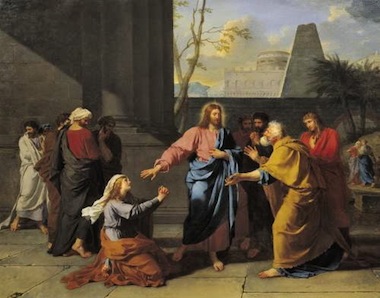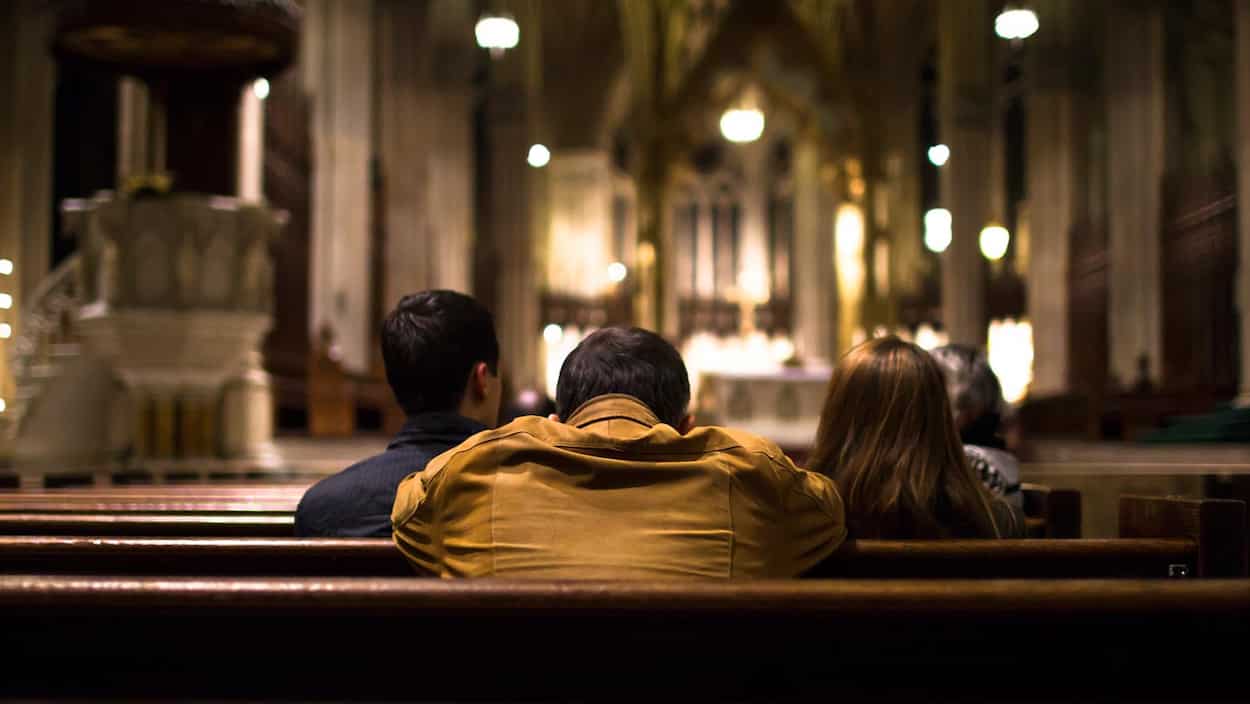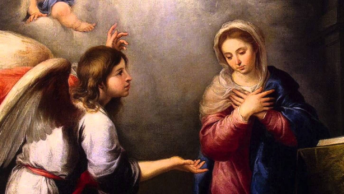
There are two stories in our Gospel (Mk 5:21-43) for this 13th Sunday in Ordinary Time. One is of the woman who lived with a physical problem for twelve years and the other is of the death of a twelve year old girl. These two stories appear to be separate and distinct, but they are purposely interwoven by the author to highlight the common elements between the two.
But first, a little bit of history will help to shed some light on the story about the woman with the physical problem. Without this historical background I think that the real impact of this story is lost. You see, during the time of Jesus, the Jewish community lived by a set of rules or laws that literally governed every aspect of their life. This law, the Mosaic Law, begins with the Ten Commandments and includes the many rules of religious observance given in the first five books of our Old Testament, these books being Genesis, Exodus, Leviticus, Deuteronomy and Numbers. In Judaism, these books are called the Torah, or “The Law.”
Leviticus Chapter 15 deals with personal uncleanness. Within this chapter are the instructions, or rules if you will, that define the limitations that the law places on women during that particular period of time that occurs every month in the life of all women. During that time Leviticus says, “She shall be unclean and set apart for seven days; and whoever touches her during that time period shall be unclean.” Leviticus goes on to say that if this natural occurrence continues unnaturally for many days, “She will not only be unclean during that entire time period, she will remain unclean for an additional seven days after it stops. And on the eighth day she must see the priest who will then make the necessary sacrifices to discharge her of her uncleanness.” (Lev 15:19-30)
Understand, however, that ritual uncleanness was not necessarily perceived as a disease. A person with leprosy would have been considered unclean that’s true, but to be ritually unclean was not a condition that would cause any physical harm. It is merely a state in which a person could not approach God or His people. A person who was considered to be unclean would, therefore, have been banned not only from participating in any and all religious practices but also from any social contact. And anyone who came in contact with an unclean individual would become defiled, or rendered ritually unclean.
This unnamed woman in our Gospel story, because of her chronic condition, would have been required to keep her distance from everyone. She could not mingle with people. People were forbidden to touch her. She would have been treated like a leper. The Gospel tells us that this woman had this problem for twelve years. In that culture, for her to have had that problem for that length of time, she would have been regarded as totally cursed by God. She would have been seen as a person who must have done something really terrible to be cursed by God in that way. She, therefore, would have been banished from, and ignored by, her community, her husband and her family.
The Gospel tells us that this woman came up behind Jesus just to touch His cloak. This was obviously a desperate, brave and courageous woman. Because anyone who she even touched, as she pushed her way through the crowd on her way to Jesus, would have become defiled. And Jesus officially became unclean the instant that she touched his clothing.
When Jesus spun around asking,
Who touched Me,
you can imagine her fear. She had just violated a major Mosaic Law and contaminated every person she came in contact with, including Jesus. The Gospel says, “She approached Jesus in fear and trembling.” (Mk 5:33) You can understand why. She not only broke The Law, she touched a holy prophet. She must have been terrified wondering what would happen to her and what He would do. But notice how tenderly Jesus responds. He called her daughter, thus comforting her and communicating His love and compassion for her.
In our second story, Jesus is approached by a synagogue official named Jairus. That statement in itself is remarkable. Jairus, being an official of the local synagogue, would have been one of the leaders of this Jewish community. His fellow leaders would undoubtedly have included the local Pharisees. Remember, it was the Pharisees that sought to silence Jesus. I am certain that Jairus would have been under great pressure to conform to the prevailing view of the Pharisees. I can only imagine the criticism he would have received from his fellow leaders for seeking this audience with Jesus. But his daughter was dying. He was a desperate man. The Gospel says he fell at the feet of Jesus. A sign of genuine humility! He obviously had faith in Jesus’ ability to heal his daughter. The Gospel says that after asking for Jesus’ help, they all immediately start heading for Jairus’s home.
It is at this point in the story that the woman approaches and interrupts the procession. To appreciate this part of the story, you have to put yourself in Jairus’s position. He’s panicky. He’s in a hurry. His daughter is dying. And now they have to stop and deal with this unclean individual. He had to be frustrated. The Gospel makes no mention of how Jairus reacted during this episode, but it does say that while Jesus was still speaking to the woman, some people arrive to inform Jairus that his daughter has already died.
You have to understand the fact that the scene presented here was not all that uncommon during the 1st century. Statistically, approximately 60% of the live births died by their mid-teens during the time of Jesus. But imagine the frustration Jairus must have felt at this point. He was hoping that Jesus would be able to save his daughter from becoming part of that statistic. But now, the delay caused by this unclean female has proven to be fatal to Jairus’s daughter. But notice how Jesus responds. He ignores the message and reassures the synagogue official by saying, “Do not be afraid; just have faith.” (Mk 5:36)
The Gospel says that when they arrive at the official’s home and are confronted by all the mourners, Jesus says, “Why all the commotion? The child is not dead.” (Mk 5:39) And we’re told that the people ridiculed Him. “We’re not ignorant. She is no longer breathing. She has no heartbeat. Her body is growing cold. We know she is gone.” But when Jesus takes the young girl by the hand and she rises at Jesus’ command, we’re told that everyone was “utterly astounded.” (Mk 5:42) We can only imagine their shock and amazement.
These two stories, although separate and distinct, each mirror the same message. One is a story of an insider, a synagogue official. The other is a story of an outsider, a woman rendered unclean by disease. One is a story of disease. The other is a story of death. In both stories, the person healed is a nameless female. One was only twelve years old. The other had been sick for twelve years. Jesus did not neglect the needs of a lowly outcast to deal with the needs of an important official. Both females would have been considered ritually unclean and Jesus was forbidden, by law, to come in contact with either one of them. But note that Jesus violated the Mosaic Law twice. He touches both. He was touched by the woman who was declared unclean by disease, and He touched a corpse, which was the most serious uncleanness anyone could contract.
The message of this Gospel can be summarized in two Scriptural verses. These two sentences are found in today’s first reading. “God did not make death.” (Wis 1:13) “God formed man to be imperishable; the image of His own nature he made him. But by the envy of the devil, death entered the world.” (Wis 2:23) Sickness and disease and death are not of God. By a process that none of us will ever fully understand this side of the grave, evil entered our world. This evil interrupts the plan of God and none of us are immune from its effects. But Jesus, the creator of all that is and the author of life, has power over this evil and its effects. The Gospel story is meant to demonstrate the fact that Jesus has power over the evil of sickness and disease and that Jesus creates life, even out of death. That’s the Good News. This evil that exists in our world does not have the final word. Death is not the end. Death has no power over the eternal life that Jesus brings. So the next time you, or someone you know, loses a loved one, don’t ever say, “It’s God’s will.” It’s not! That is not what God intended in His creation. Our bodies are designed to last forever. “God formed man to be imperishable.” When our body is injured, it repairs itself.
The message of Scripture is that Jesus saves. That is easy to say and wonderful to hear but we need to understand just what we mean by the word “salvation”, and the immense power that is expressed in that word. So just what is salvation? Pope John Paul II (Crossing the Threshold of Hope, pp.70) gave a beautiful answer to that question and I would like to close by repeating his answer.
To save means to liberate from evil. This does not refer only to social evils, such as injustice, coercion, exploitation. Nor does it refer only to disease, catastrophes, natural cataclysms, and everything that has been considered disaster in the history of humanity.
To save means to liberate from radical, ultimate evil. Death itself is no longer that kind of evil, if followed by the Resurrection. And the Resurrection comes about through the work of Christ. Through the work of the Redeemer death ceases to be an ultimate evil; it becomes subject to the power of life.
The world does not have such power. The world, which is capable of perfecting therapeutic techniques in various fields, does not have the power to liberate man from death. And, therefore, the world cannot be a source of salvation for man. Only God saves, and He saves the whole of humanity in Christ.








